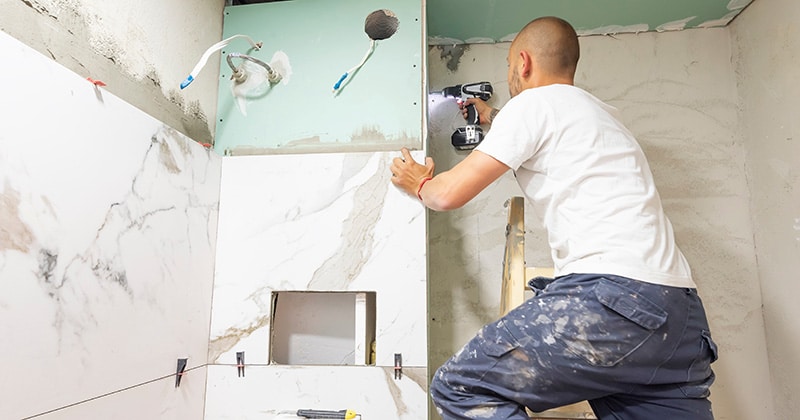Are you toying with the idea of going into the remodeling business for yourself? Are stalling out, unsure how to start a remodeling business? Well, it’s time to start looking for some direction to help you make a move.
This article walks you through the steps you need to get off to a successful start. You’ll learn about studying the competition and writing a business plan for your remodeling business. You’ll also get necessary information about building an online presence and marketing to attract customers.

Step 1: Conduct Market Research and Analysis
Before you set up shop, you want to do some research to set yourself up for success. Discover where you may fit in the industry and your local community.
Consider the latest remodeling trends for areas of specialty. Some areas that are hot right now include:
- Sustainability and green homes
- Technology for ultra convenience
- Energy efficiency for climate change
- Quiet luxury and elegance
- Accessibility for aging in place
- Blending indoor and outdoor living
How do your skills and resume match up with those trends? Can you bring clients the latest in remodeling?
Those trends above are popular nationally. But what about in the area you intend to serve? There are a few questions you should ask yourself when conducting research:
- What kinds of real estate are changing hands? This is where remodeling businesses typically have lots of opportunities.
- How old would your typical client be? What is their average budget for remodeling?
- How many other remodeling businesses serve the area already? How can you stand out from the competition?
Ideally, you want your business to have a unique value proposition. Sometimes, this is called a unique selling proposition or USP. That’s something that only you bring to prospective clients.
Maybe you can do curb appeal improvements for home sellers on a budget. Or perhaps you are gifted at replicating historic homes with new construction. That’s your calling card.
Step 2: Develop a Business Plan
You’ve done your research and analyzed your role in the industry. Now, it’s time to write up a business plan. This plan is your roadmap for the future of your company. It’s also a document that outlines your plans for the business if you need funding to get started.
You may need to make capital purchases, like a truck or equipment. A bank will want to see that you’ve thought carefully about your business before lending you money. A solid business plan shows them you’re more likely to succeed and are, therefore, a lower financial risk.
According to the US Bureau of Labor Statistics, private construction companies have a failure rate of over 82% across 20 years. Lenders want to see you’re going to be in the 18% that thrive.
What is included in a business plan? It should have the following sections:
- An executive summary that gives a birds-eye view of the company, including your mission
- Market research about your client base and competition, as discussed above
- Information about how the company will be structured, the number of employees or contractors, etc.
- A list of the services you will offer, plus pricing models
- Financial projections, including profit and loss statements and what you need to earn to break even
- Short-term and long-term business goals (the next 3-5 years)
For the last section, it will be helpful to have a certified public accountant (CPA) help you.
FROM ONE OF OUR PARTNERS: 7 Steps for Creating a Remodeling Business Plan
Step 3: Register Your Business and Obtain Licenses
A CPA can also assist you with suggestions for different incorporation options and how they affect taxation. You want to find the right legal structure, such as sole proprietorship, partnership, or LLC.
If you will be partnering with another remodeling professional, it’s smart to have an attorney draw up a contract. The contract should outline the details of how you will work together. Be sure to cover compensation and responsibilities.
Every state has different requirements regarding licensing, registration, and certification. You will have to find which laws apply to your state and follow them. They will likely dictate that you also carry various types of insurance. This includes liability coverage and workers’ compensation.
Other types of insurance you may need include:
- Commercial auto for vehicles used in your business operation
- Cyber insurance if you take digital payments
- Property insurance to protect your equipment and tools
- Bonds for when your reputation is on the line for quality and timeliness
Step 4: Build a Team of Professionals
You will have to figure out the labor side of completing projects for your clients. Do you have people in mind to work under you on each job? If not, you will need to advertise and interview employees. You might find good candidates at your local vocational or technical college, too.
Some remodelers prefer to subcontract for each job. This method is preferable if your needs change for every project. You will then want to assemble a database of reputable subcontractors you can call when necessary, like:
- Plumbers
- Electricians
- Garage door specialists
- Door and window contractors
- Landscapers
- Painters
- Lighting experts
- Chimney and masonry pros
- Roofers
- Concrete specialists
Don’t forget to think about where you will be obtaining supplies and perhaps appliances or large fixtures. You may want to set up business accounts there so you can charge items.
FROM ONE OF OUR PARTNERS: How to Start a Home Renovation Business

Step 5: Create a Strong Brand Identity
Above, you read that you will be focusing on your unique value proposition or USP to stand out in a competitive industry. It will help if you build a strong brand identity alongside that.
What will the name of your company be? It should be something that’s easy for clients to remember and spell.
It may be tempting to go with “AAA Remodeling,” as that comes first alphabetically in various directories. But you can certainly come up with something more memorable if you put your mind to it.
You will also want a logo to go with your brand. If this is outside your wheelhouse, hire a graphic designer to do it for you.
The visual elements of your brand are important, as they make your company more instantly recognizable. You will use them on invoices, business cards, your vehicles, and your website, so choose something you will like long-term.
Step 6: Establish an Online Presence
Speaking of websites, you definitely need one. A website makes your business look professional and legitimate. It’s the perfect place to showcase your work so prospects can see if you’re a good fit for them.
And when done right, a website is how new clients will find you online. How does that work?
You want to use search engine optimization (SEO) strategies in setting up your site. Those include:
- Make your website responsive for all kinds of devices, including mobile phones and tablets.
- Use keywords that customers would use when searching for a remodeling business online.
- State your location (town and state), with some information about local landmarks thrown in.
- Add links to authoritative websites (.gov, .edu, etc.) in your blog posts.
All of these strategies together help search engines like Google rank your business higher in searches. That way, customers who might not know about your business can find you quickly.
You also want to develop an online presence in two other areas:
- Social media platforms
- Online review sites
The latter will come once you’ve done some jobs and can ask customers for reviews. First, focus on setting up a few professional social media accounts. Don’t try to do them all. Instead, pick a couple where you can excel.
Which social media accounts are best for remodeling businesses? You want to go where your clients hang out.
You also want to think about which ones work best for your industry. Facebook is a good choice for several reasons. People who have money to spend on remodeling tend to have Facebook accounts. Plus, you can use their advertising program (see below) and get on local community group pages.
Instagram is trendy right now and might be another option. It’s highly visual, which lends itself well to remodeling.
YouTube is another visual platform. And it’s used by 83% of adults.
With a video channel, you have virtually unlimited opportunities to show off your work. And you can establish your business as the expert in your area with how-to videos and easy DIY projects.
Step 7: Market Your Remodeling Business
Marketing is the process of promoting your business to attract customers. It’s especially important for new businesses that don’t already have a client base.
You want to use multiple marketing methods. Different approaches will work with different prospective customers, aka leads. The goal is to convert your leads into paying customers.
To generate leads, you can try a combination of these tactics:
- Promoting your business on social media
- Buying print, digital, or sign advertisements
- Supporting local groups in return for ads
- Cross-promoting with subcontractors
- Writing guest posts on other company’s blogs
Be sure to include at least one place on your website to collect email addresses. Then, you can start an email list.
Use the list to send out monthly newsletters or discount coupons for new customers. You can also set up loyalty programs such as “Refer a friend and get a discount on your next project.”
Over time, you’ll have customer leads in different places in your “sales funnel.” How do you keep track of them?
You can use a CRM (customer relationship management) software program like MarketSharp to help automate the process. That way, you can focus on jobs and in-person estimates.
You’ll get alerts when you need to contact a potential customer. And the software will help with email nurture campaigns that move prospects to commitment.
FROM ONE OF OUR PARTNERS: Use These Big Marketing Ideas to Attract Customers to Your Small Business
Step 8: Provide Exceptional Customer Service
Of course, giving customers the best service possible is some of the best marketing you can do. From the start, you want to use efficient project management processes to stay on target with completion dates.
Always make sure your customers are happy with your work. Ask them to submit an online review. You can send a reminder with a link a day or two after finishing a project. You can also ask satisfied customers if they’ll refer you to friends or neighbors.
Project management software will help automate many administrative tasks and keep you organized. In fact, you can use MarketSharp for this too. It will integrate your CRM with other management to-dos, so everything is in one handy place online.
The goal of using software for contractors is to spend more time on jobs. That’s where your revenue comes from. So, you want to streamline administrative tasks as much as possible. Let them run in the background while you’re spending more time on the job site.
Tips to Start Building Your Remodeling Business Today
Are you ready to begin setting up your remodeling business right now? Here are some quick tips you can use today to get going:
Consider joining a local chapter of the National Association of the Remodeling Industry (NARI) to network. You could also attend functions for your local Chamber of Commerce. Membership groups like Rotary International are another great option.
Become proficient at writing estimates. If you choose the right contractor software, you will be able to do this more easily and accurately.
Be sure to set up a business bank account that’s separate from your personal account. It will make it much easier to keep your finances organized. Be aware, though, that your personal credit profile will be used for most business lending decisions.
Set up your billing and invoicing to benefit your cash flow. If you don’t have a lot of runway, think about using short billing cycles. Ask customers to pay on receipt or within 30 days rather than months later. Or get a deposit up front for materials and supplies.
Figure out how you will handle things like sick and vacation days when working for yourself. Everyone needs time off occasionally. Create a healthy work-life balance early on so you don’t burn out. You will appreciate it when your business is thriving years from now.
FROM ONE OF OUR PARTNERS: 5 Tips for Renovation Companies That Work

